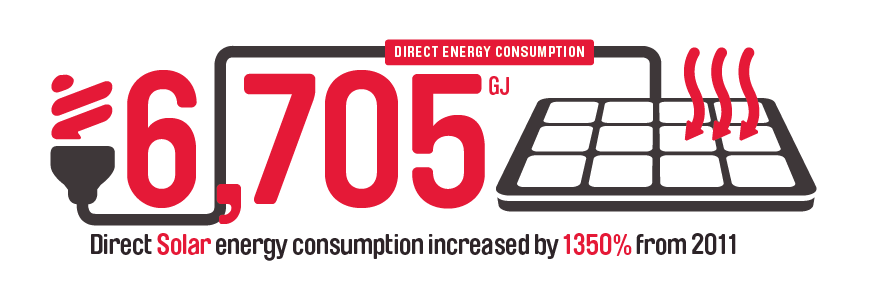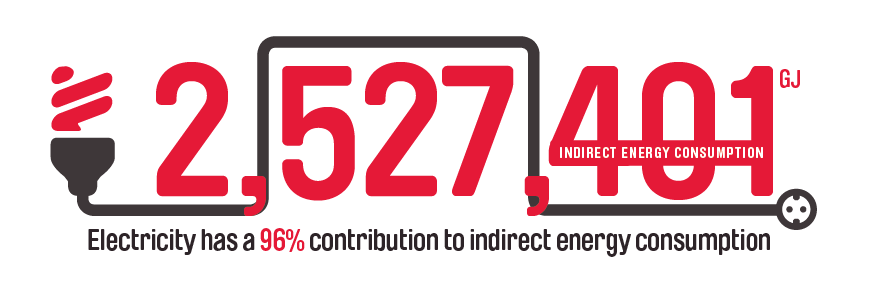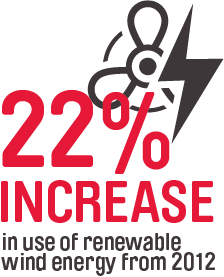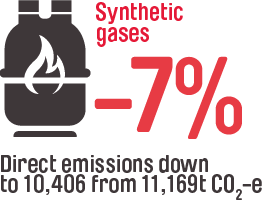The greatest proportion of total GHG Emissions is indirect, arising from the purchase and consumption of electricity
The amount and type of energy source consumed is the driver of the Group’s GHG emissions. Therefore, maintaining focus on increasing the energy efficiency of Westfield’s assets can help to reduce energy costs as well as GHG emissions.
With a portfolio that sees changes through the composition of its assets through acquisitions and divestments, as well as to its size through redevelopments, the Group’s approach to date has been to set specific energy and emissions targets and associated efficiency targets by asset and activity, as opposed to setting total targets across the Group. Each asset and activity will have a target based on its specific parameters, such as current performance, technical limitations and market demand, allowing for a more detailed and actionable approach to energy and emissions reductions.
Energy consumption
Direct energy consumption
Westfield’s direct energy consumption decreased by almost a quarter (24%) during 2012. This is predominantly due to a 25% reduction in natural gas consumption which comprises the majority of total direct energy consumed. This significant reduction in natural gas is due to the divestment of sites, particularly in the United States, and the reduction in the consumption of natural gas at the US corporate office. The consumption of jet fuel also reduced significantly in 2012, by 32%, due to reduced flights in both the United States and Australia.
While an overall small contributor to the total amount of direct energy consumed, Westfield has significantly increased the electricity that was directly generated
on-site from solar panels in the United States up to 6,705 GJ.
Westfield continues to focus on energy efficiency initiatives relating to fuel.
Indirect energy consumption
As the largest source of energy consumed, Westfield has continued to invest in technology for metering, management and reporting systems for electricity, improving the accuracy and granularity of data collected and giving facilities greater oversight of opportunities to improve energy efficiency. In 2012 electricity consumption decreased by 5% year-on-year, in part due to the ongoing initiatives in each country to improve efficiency. These have included lighting schedule adjustments; smoke damper modifications; building management software upgrades; infrastructure replacements and process improvements. The sale of some assets in the United States has also contributed to this decline.
In Australia, increases in electricity consumption due to the completion of project centres, for example, were offset by the implementation of IELVS (Integrated Extra Low Voltage Systems) systems at Burwood and Bondi and ongoing saving initiatives at other centres. In addition, the move of Westfield’s corporate headquarters in 2011/2012 to the Westfield Sydney precinct (which includes the newly constructed 6-star green star office tower at 85 Castlereagh Street, and the 5-star green star refurbished office tower at 100 Market St) contributed to the reduction of headquarter electricity consumption.
For the Australian portfolio, Westfield has set a shopping centre portfolio electricity consumption cap at 2008 levels. As at December 31, 2012 electricity consumption has decreased from 2008 levels by around 7%. From 2012, Westfield Australia has capped usage at 2011 consumption levels through until 2015. Westfield Australia is on track to achieve this goal, with electricity consumption in 2012 only 0.2% higher than 2011.
In the United States, the portfolio-wide enterprise management system ecoWISE has been implemented, allowing real time monitoring and management of all electrical equipment in the centres and maximising efficiency. This has helped to lead to a 7% reduction in Westfield US electricity use in 2012, compared to 2011. The
portfolio-wide rollout of the ecoWISE system is anticipated to help significantly reduce the Group’s carbon emissions over the first five years of implementation.
In the United Kingdom, there are a variety of initiatives to reduce energy consumption. At Westfield’s London head office wet waste was incinerated for renewable energy as part of the building-wide strategy for recycling. Across the shopping centre portfolio, facilities managers and building services managers have continued to reduce energy consumption by monitoring the building management system, adjusting non-essential lighting, such as mall and car park lighting times and schedules, and implementing a number of lighting retrofitting programs across the portfolio including the replacement of dichroic lights by LED. In addition to a reduction in number of sites, these initiatives helped to reduce the United Kingdom’s electricity consumption by 1.4%, even with Westfield Stratford being online for a full 12 months this year as opposed to 3 months last year. Westfield Stratford City (despite contributing to an absolute increase in carbon emissions) has set the benchmark for energy efficiency in retail centres in Westfield’s portfolio, with its CCHP (Combined Cooling Heating and Power) unit generating 75% of the site’s energy requirements.
Electricity consumption in New Zealand was reduced by almost 9% in 2012. In addition to the sale of three sites, this is due to improved operational efficiencies and the continued tracking of electricity usage. Ongoing monitoring of usage data and subsequent operational efficiencies will continue to be a focus for New Zealand as they offer the greatest opportunities for the reduction of electricity and waste, and therefore emissions.
GHG emissions
The international policy and regulatory landscape relating to GHG emissions and energy is continually evolving as governments respond to the challenge of climate change. This is underpinned by reporting obligations essential to facilitate accurate measuring and monitoring of emissions and energy, and informed decision-making by stakeholders. It is within this context that Westfield voluntarily reports its environmental data in its annual Sustainability Report.
In 2012 Westfield’s total GHG emissions were 664,450 metric tonnes CO2-equivalents (tCO2e), comprising 25,187 tCO2e direct emissions (Scope 1), 458,569 tCO2e indirect emissions (Scope 2) and 180,694 tCO2e of other indirect emissions (Scope 3). This represents a 5% decrease in total emissions.
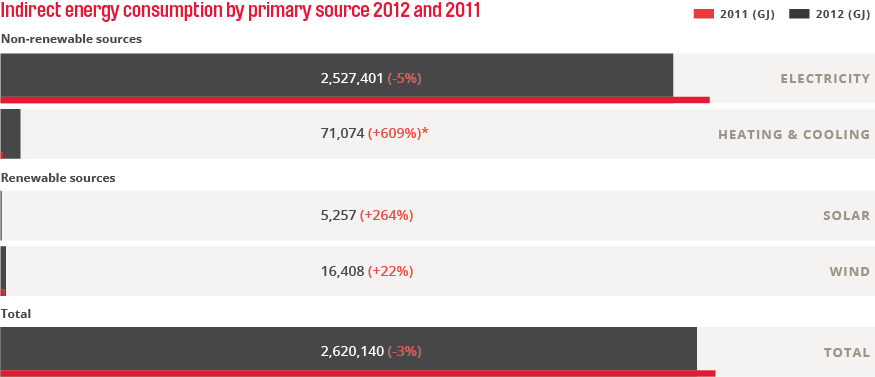


Direct emissions (scope 1)
Around half of Westfield’s direct emissions resulted from the combustion of natural gas and other fuels on-site and transport fuels consumed by Westfield’s controlled vehicles. The remainder of Westfield's direct emissions have resulted from the leakage of refrigerant gases.
Indirect emissions (scope 2)
The greatest proportion of Westfield’s total GHG emissions comprises indirect emissions, arising from the purchase and consumption of electricity and heat or steam for heating and cooling common areas within the Group’s shopping centres and office space. In the United States and the United Kingdom, indirect emissions are being reduced through the consumption of renewable sources. In 2012, solar energy consumption was increased by 264% (across the United States and United Kingdom) and wind energy consumption by 22% (United States).
Other indirect emissions (scope 3)
Westfield voluntarily reports selected other indirect emissions in accordance with guidance from the GHG Protocol. This includes: emissions generated by the disposal of waste to landfill; business travel by air, taxi, train and car; and employees commuting to and from work. Westfield also reports the full fuel cycle emissions associated with the purchase of fuels and emissions arising from distribution and transmission losses of purchased electricity where local Scope 3 emission factors are available.
There was a 4% decrease in Scope 3 emissions in 2012, chiefly due to a reduction in waste (in part due to ongoing recycling training programs in Australia), and a reduction in transmission and distribution losses from purchased electricity, due to reduced electricity consumption.
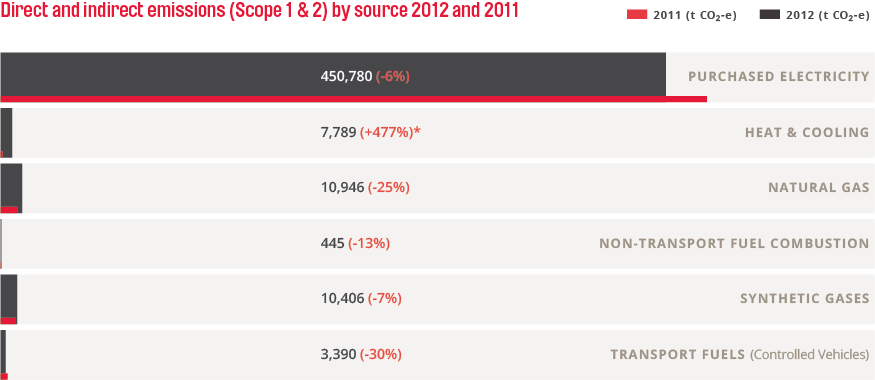
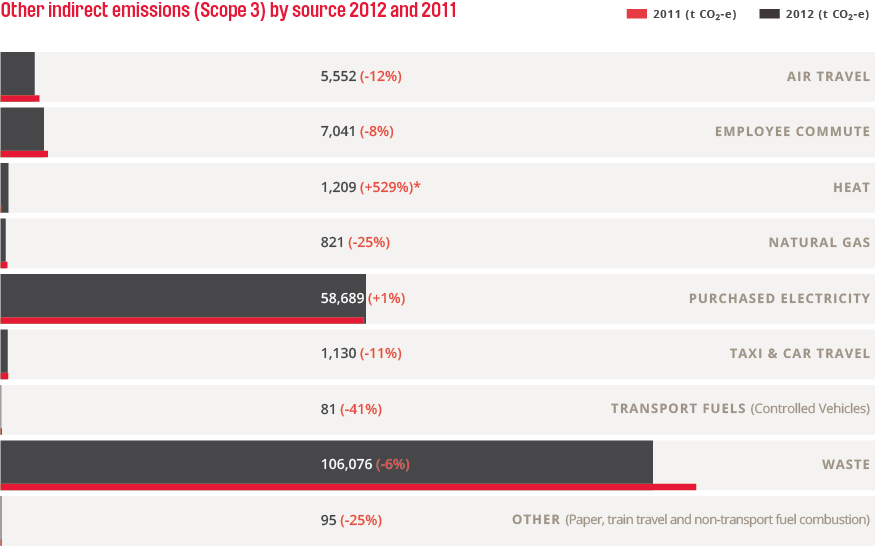
- The increases in direct and indirect energy consumption and associated emissions for heating and cooling relates to usage at Westfield Stratford City, which was operational for the reporting period of 2012. (The centre's energy data was not included in 2011 as it opened in September that year.)

